The city of Hiroshima in western Japan marks the 75th anniversary of the world’s first nuclear attack on Thursday.
Three days after its Aug. 6, 1945, bombing of Hiroshima, the United States dropped a second atomic bomb on Nagasaki. Japan surrendered on Aug. 15, ending World War II and, more broadly, its aggression toward Asian neighbors that had lasted nearly half a century.
Here's a look at that day in Hiroshima 75 years ago.
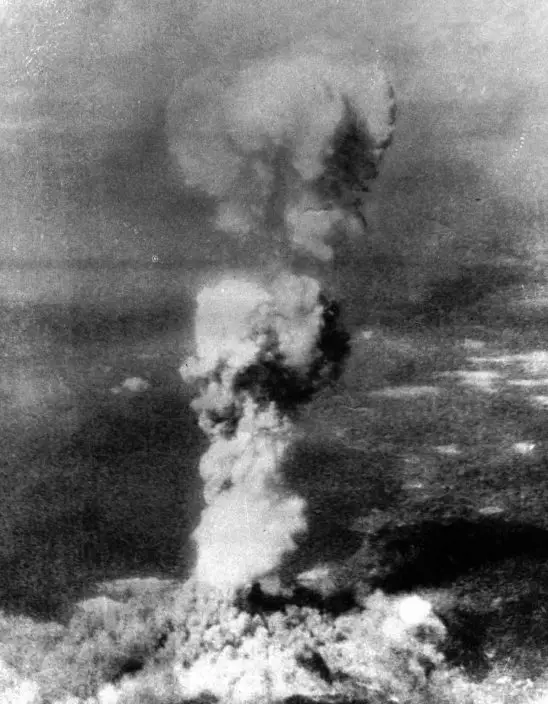
FILE - In this Aug. 6, 1945, file photo released by US Air Force, a column of smoke rises 20,000 feet over Hiroshima, western Japan, after the first atomic 5-ton "Little Boy" bomb was released. Hiroshima was targeted because it was a major Japanese military hub filled with military bases and ammunition facilities. The city of Hiroshima on Thursday, Aug. 6, 2020 marks the 75th anniversary of the world’s first nuclear attack. (George R. CaronUS Air Force via AP, File)
Q. Why was Hiroshima chosen as a target?
A. Hiroshima was a major Japanese military hub with factories, military bases and ammunition facilities. Historians say the United States picked it as a suitable target because of its size and landscape, and carefully avoided fire bombing the city ahead of time so American officials could accurately assess the impact of the atomic attack. The United States said the bombings hastened Japan’s surrender and prevented the need for a U.S. invasion of Japan. Some historians today say Japan was already close to surrendering, but there is still debate in the U.S.
Q. What happened in the attack?
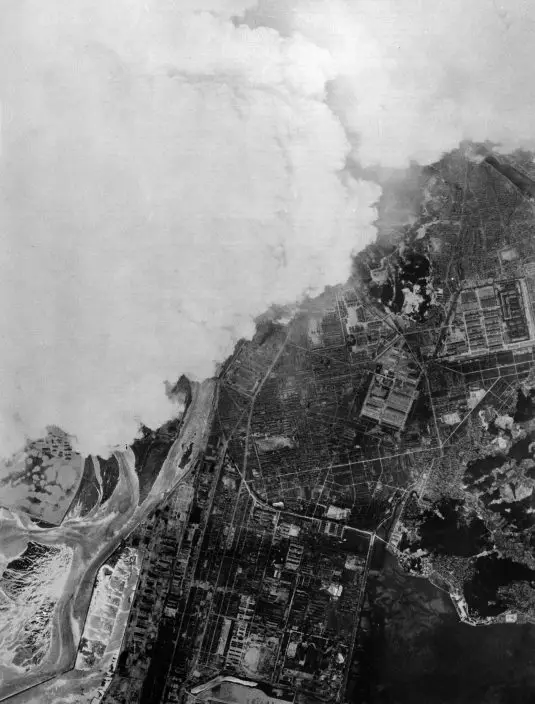
FILE - In this Aug. 6, 1945, file photo released by the U.S. Air Force, white smoke rises from detonation of the atomic bomb over Hiroshima, western Japan. At 8:15 a.m., the U.S. B-29 bomber Enola Gay dropped the 4-ton “Little Boy” uranium bomb from a height of 9,600 meters (31,500 feet) on the city center, targeting the Aioi Bridge. The bomb exploded 43 seconds later, 600 meters (2,000 feet) above the ground. (U.S. Air Force via AP, File)
A. At 8:15 a.m., the U.S. B-29 bomber Enola Gay dropped a 4-ton “Little Boy” uranium bomb from a height of 9,600 meters (31,500 feet) on the city center, targeting the Aioi Bridge. The bomb exploded 43 seconds later, 600 meters (2,000 feet) above the ground. Seconds after the detonation, the estimated temperature was 3,000-4,000 degrees Celsius (5,400-7,200 degrees Fahrenheit) at ground zero. Almost everything within 2 kilometers (1.2 miles) of ground zero was destroyed by the blast and heat rays. Within one hour, a “black rain” of highly radioactive particles started falling on the city, causing additional radiation exposure.
Q. How many people were killed?
A. An estimated 140,000 people, including those with radiation-related injuries and illnesses, died through Dec. 31, 1945. That was 40% of Hiroshima’s population of 350,000 before the attack. Everyone within a radius of 500 meters (1,600 feet) from ground zero died that day. To date, the total death toll, including those who died from radiation-related cancers, is about 300,000. Hiroshima today has 1.2 million residents.
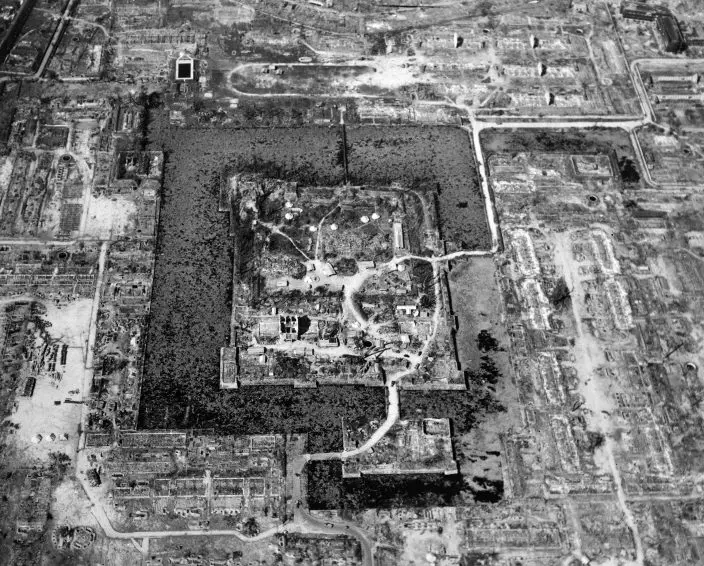
FILE - This Aug. 6, 1945, file photo released by the U.S. Air Force shows the total destruction of Hiroshima, western Japan, as the result of the first atomic bomb dropped. An estimated 140,000 people, including those with radiation-related injuries and illnesses, died through Dec. 31, 1945. That was 40% of Hiroshima’s population of 350,000 before the attack. (U.S. Air Force via AP, File)
Q. What effect did radiation have?
A. Many people exposed to radiation developed symptoms such as vomiting and hair loss. Most of those with severe radiation symptoms died within three to six weeks. Others who lived beyond that developed health problems related to burns and radiation-induced cancers and other illnesses. Survivors have a higher risk of developing cataracts and cancer. About 136,700 people certified as “hibakusha,” as victims are called, under a government support program are still alive and entitled to regular free health checkups and treatment. Health monitoring of second-generation hibakusha began recently. Japan’s government provided no support for victims until a law was finally enacted in 1957 under pressure from them.
Q. What are those colorful folded paper cranes for?

FILE - In this Sept. 7, 1945, file photo, an unidentified man stands next to a tiled fireplace where a house once stood in Hiroshima, western Japan. The Aug. 6, 1945, bombing was the world’s first nuclear attack. An estimated 140,000 people, including those with radiation-related injuries and illnesses, died through Dec. 31, 1945. That was 40% of Hiroshima’s population of 350,000 before the attack. (AP PhotoStanley Troutman, Pool, File)
A. “Origami” paper cranes can be seen throughout the city. They became a symbol of peace because of a 12-year-old bomb survivor, Sadako Sasaki, who, while battling leukemia, folded paper cranes using medicine wrappers after hearing an old Japanese story that those who fold a thousand cranes are granted one wish. Sadako developed leukemia 10 years after her exposure to radiation at age 2, and died three months after she started the project. Former U.S. President Barack Obama brought four paper cranes that he folded himself when he visited Hiroshima in May 2016, becoming the first serving American leader to visit. Obama's cranes are now displayed at the Hiroshima Peace Memorial Museum.
Follow Mari Yamaguchi on Twitter at https://www.twitter.com/mariyamaguchi
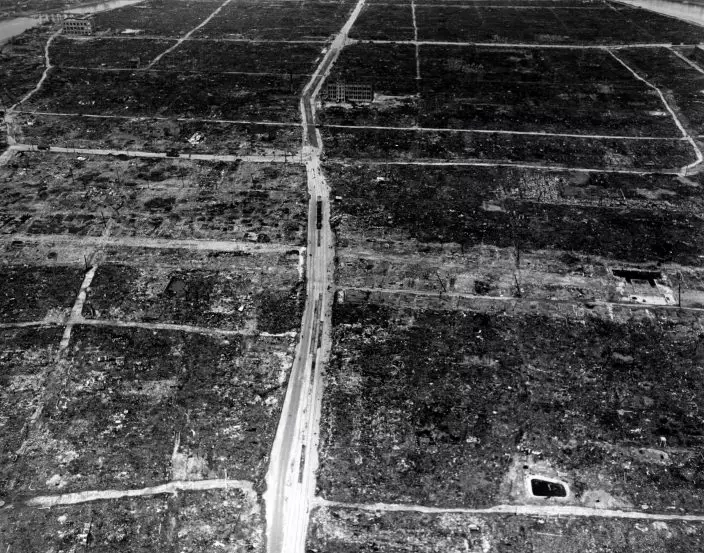
FILE - In this Sept. 5, 1945, file aerial photo, the landscape of Hiroshima, western Japan, shows widespread rubble and debris, one month after the atomic bomb was dropped. An estimated 140,000 people, including those with radiation-related injuries and illnesses, died through Dec. 31, 1945. That was 40% of Hiroshima’s population of 350,000 before the attack. (AP PhotoMax Desfor, File)
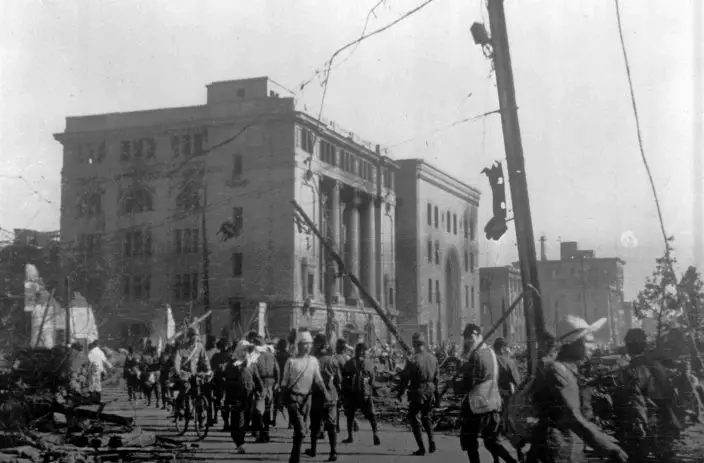
FILE - In this Aug 8, 1945, photo, soldiers and civilians walk through the grim remains of Hiroshima, western Japan, two days after the atomic bomb explosion. The building on left with columned facade was the Hiroshima Bank. To its right, with arched front entrance, was the Sumitomo Bank. An estimated 140,000 people, including those with radiation-related injuries and illnesses, died through Dec. 31, 1945. That was 40% of Hiroshima’s population of 350,000 before the attack. (AP Photo, File)
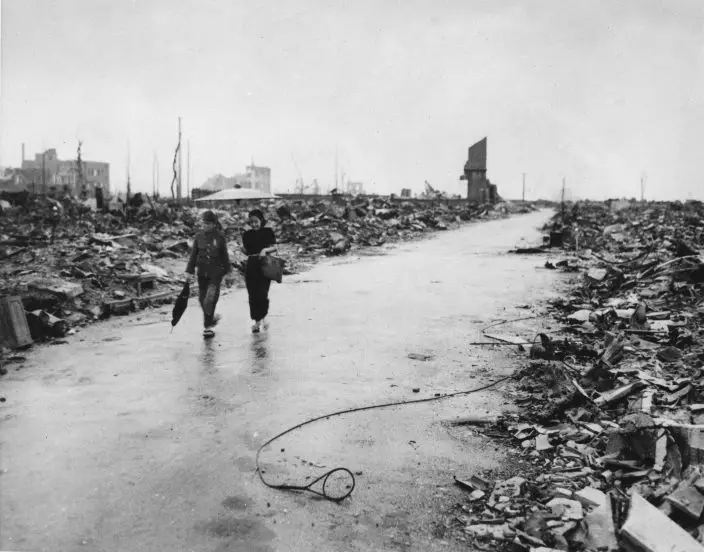
FILE - In this Sept. 8, 1945, file photo released by U.S. Air Force, two people walk on a cleared path through the destruction resulting from the Aug. 6 detonation of the first atomic bomb in Hiroshima, Japan. An estimated 140,000 people, including those with radiation-related injuries and illnesses, died through Dec. 31, 1945. That was 40% of Hiroshima’s population of 350,000 before the attack. (U.S. Air Force via AP, File)
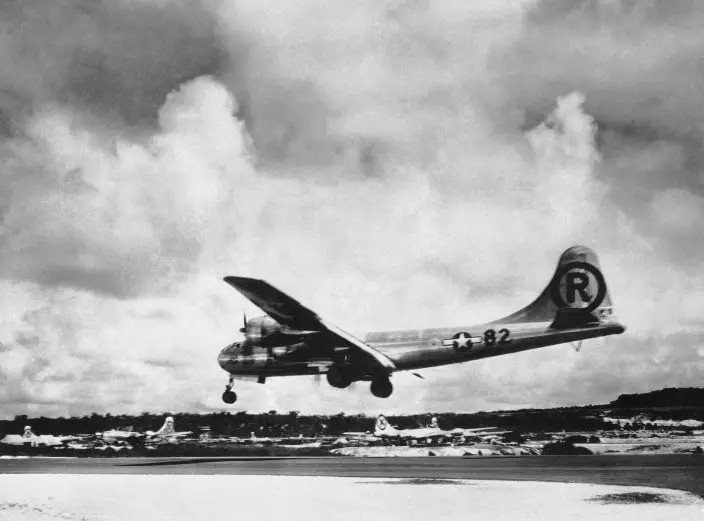
FILE - In this Aug. 6, 1945, file photo, the "Enola Gay" Boeing B-29 Superfortress lands at Tinian, Northern Mariana Islands, after the U.S. atomic bombing mission against the Japanese city of Hiroshima. Enola Gay dropped the 4-ton “Little Boy” uranium bomb from a height of 9,600 meters (31,500 feet) on the city center, targeting the Aioi Bridge. (AP PhotoMax Desfor, File)
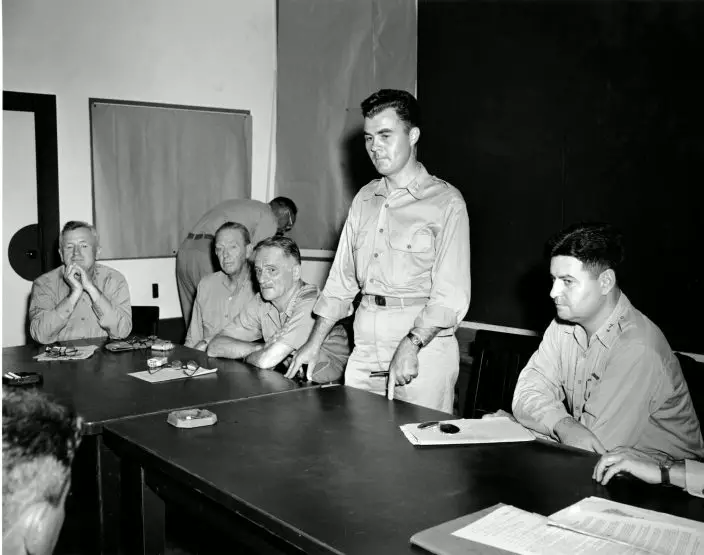
FILE - In this Aug. 7, 1945, file photo, Col. Paul W. Tibbets, standing, pilot of the B-29 Enola Gay which dropped the atomic bomb on Hiroshima, western Japan, describes the flight during a news conference at Strategic Air Force headquarters on Guam, one day after the atomic bombing. At 8:15 a.m., the U.S. B-29 bomber Enola Gay dropped the 4-ton “Little Boy” uranium bomb from a height of 9,600 meters (31,500 feet) on the city center, targeting the Aioi Bridge. (AP PhotoMax Desfor, File)

FILE - In this Aug. 6, 1945, file photo, survivors are seen as they receive emergency treatment by military medics shortly after the first atomic bomb ever used in warfare was dropped by the United States over Hiroshima, western Japan. Many people exposed to radiation developed symptoms such as vomiting and hair loss. Most of those with severe radiation symptoms died within three to six weeks. Others who lived beyond that developed health problems related to burns and radiation-induced cancers and other illnesses. (AP Photo, File)
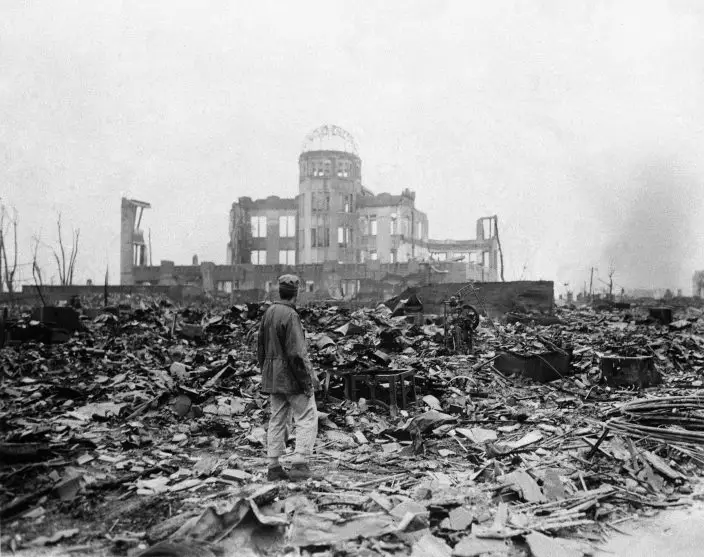
FILE - In this Sept. 8, 1945, file photo, an allied correspondent stands in a sea of rubble before the shell of a building that once was a movie theater in Hiroshima, western Japan, a month after the first atomic bomb ever used in warfare was dropped by the U.S. to hasten Japan's surrender. Many people exposed to radiation developed symptoms such as vomiting and hair loss. Most of those with severe radiation symptoms died within three to six weeks. Others who lived beyond that developed health problems related to burns and radiation-induced cancers and other illnesses. (AP PhotoStanley Troutman, Pool, File)
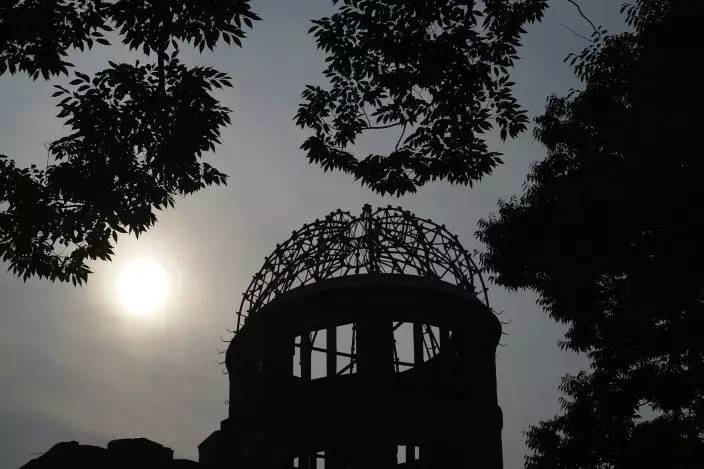
The Atomic Bomb Dome is seen at dusk in Hiroshima, western Japan, Monday, Aug. 3, 2020. The city of Hiroshima on Thursday, Aug. 6 marks the 75th anniversary of the world’s first nuclear attack. (AP PhotoEugene Hoshiko)
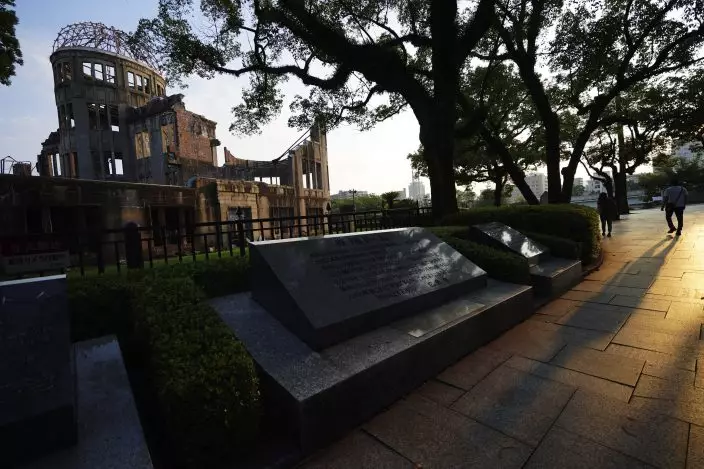
The Atomic Bomb Dome is seen at dusk in Hiroshima, western Japan, Sunday, Aug. 2, 2020. The city of Hiroshima on Thursday, Aug. 6 marks the 75th anniversary of the world’s first nuclear attack. (AP PhotoEugene Hoshiko)

The Atomic Bomb Dome is seen at dusk in Hiroshima, western Japan, Sunday, Aug. 2, 2020. The city of Hiroshima on Thursday, Aug. 6 marks the 75th anniversary of the world’s first nuclear attack. (AP PhotoEugene Hoshiko)
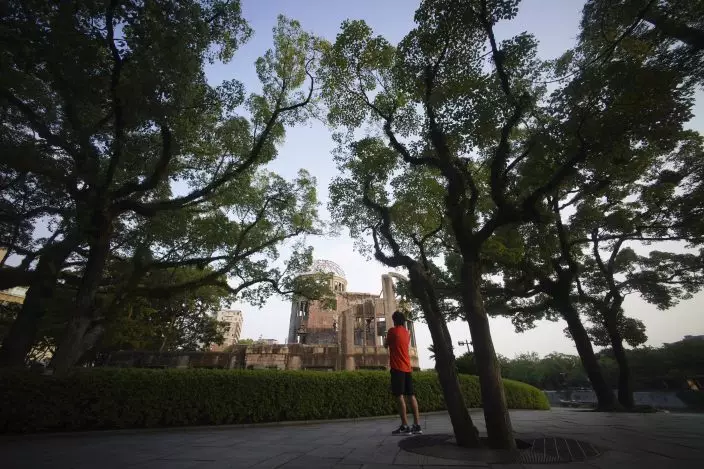
A man looks at the Atomic Bomb Dome in Hiroshima, western Japan, Sunday, Aug. 2, 2020. The city of Hiroshima on Thursday, Aug. 6 marks the 75th anniversary of the world’s first nuclear attack. (AP PhotoEugene Hoshiko)
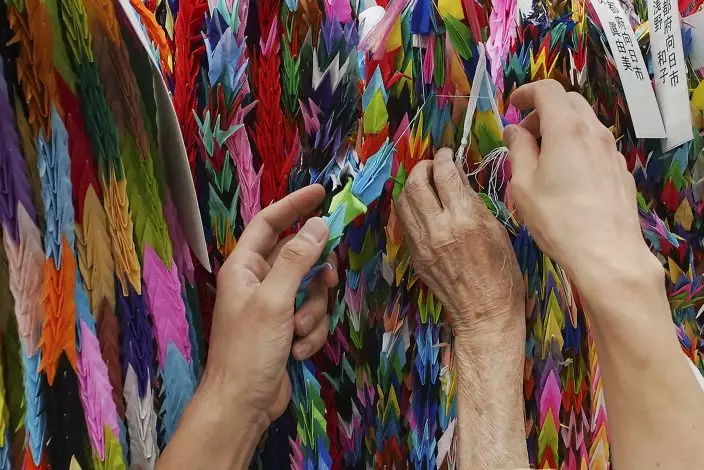
Hatsue Onda, center, is helped by Kengo Onda to offer strings of colorful paper cranes to the victims of the 1945 Atomic bombing near Hiroshima Peace Memorial Museum in Hiroshima, western Japan, Monday, Aug. 3, 2020. The origami cranes that can be seen throughout the city became a symbol of peace because of atomic bomb survivor Sadako Sasaki, who, while battling leukemia, folded similar cranes using medicine wrappers after hearing an old Japanese story that those who fold a thousand cranes are granted one wish. (AP PhotoEugene Hoshiko)


